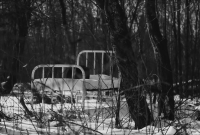Support strong Canadian climate journalism for 2025
When Simon Baker became the host of the television series Native Planet, he witnessed how climate change was affecting Indigenous people across the globe.
“It opened up my eyes, seeing what was happening around the world, and then I got to come back home and see [that] it's happening here, too,” the Squamish, Haida and Cree actor and producer told Canada’s National Observer.
Baker has worked in the film industry for over two decades. He had his first role at age nine and was most recently on set for a film called The Birds Who Fear Death. He has seen first-hand how sustainability is often forgotten in the film industry.
“You never really think about the impact that our industry [has],” he said.
But everyone — including those in the film industry — needs to be accountable for what humans are doing to the environment, he added.
Baker recently moderated a panel called “Sustainability through an Indigenous lens,” kicking off the Sustainable Production Forum (SPF), a month-long conference on sustainability in the film industry.

The event took place in Vancouver, a city on the unceded lands of the Squamish, Musqueam and Tsleil-Waututh nations whose nickname is “Hollywood North” because of its many film productions.
In his welcoming address, Dennis Thomas (Whonoak), an elected councillor for Tsleil-Waututh Nation, pointed out the nations didn’t have a word for “sustainability” in their languages.
“It was inherent in who we are,” he said.
The film industry is far from clean. The average carbon footprint of one feature film is 3,370 metric tonnes — the same as driving 726 gas-powered cars per year — according to a report published by the Sustainable Production Alliance. With a dependence on diesel generators to power most sets, fuel is the greatest contributor, with air travel and utilities coming in second and third place.
This carbon calculation doesn’t account for the upstream (everything that comes on a set) and downstream (everything that leaves a set) greenhouse gas emissions, said Zena Harris, SPF’s creative director and president of Green Spark Group, a sustainability consultancy company.
“We don't yet have a complete picture of carbon emissions as an industry, but we do have some good data to go on. And we know where to focus our efforts.”
With careful planning, film productions can cut down on a lot of their emissions, Harris said, “really thinking through like, 'OK, if we want to get this shot, how would we do it without using five diesel generators? Could we do it with one? Could we use a battery power station instead?’”
Not only does the film industry pump carbon dioxide into the air, but climate change also threatens the industry — wildfires and floods could halt productions.
“There are big risks to the sustainability of the industry long term,” Harris said, “And we, as an industry, need to contribute to the solution.”
Filmmakers should think carefully about the role of Indigenous people in the film industry, said Faith Sparrow-Crawford, a member of Musqueam Nation and co-founder of Salish Locations, a company that liaises between property owners and production companies.

“When you're thinking about working with Indigenous folks, in any context globally, you have to start by putting yourselves in a local context and start thinking about the fact that we, as Indigenous people, come from this land,” she said.
The film industry must create space at all decision-making tables for Indigenous people, she added.
“We’ve been taught by the Earth how to interact with the Earth,” she continued. “We’re bringing thousands of years of knowledge about this place to everything that we do.”







Comments